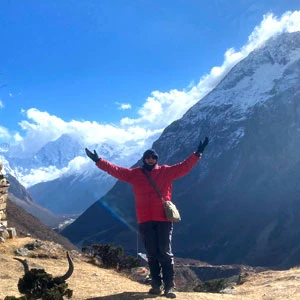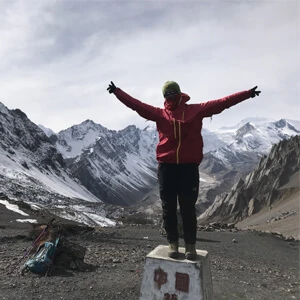Kanchenjunga Circuit Trek Overview
If you are chasing real wilderness, the Kanchenjunga Circuit Trek is one of the most remote, culturally immersive, and scenic trekking adventures in Eastern Nepal. Located in Taplejung district, this off-the-grid trail takes you through remote villages, epic landscapes, and two iconic spots: Kanchenjunga North Base Camp (Pangpema) and South Base Camp (Oktang) within the Kanchenjunga Conservation Area.
Once a restricted area, the Kanchenjunga region was opened to trekkers in 1988. The 22-day Kanchenjunga trekking route winds through alpine forests, glacial valleys, and past giants like Mt. Jannu, Kumbhakarna, and Rathong. You will hike where snow leopards roam and pass through Limbu and Rai villages where Tibetan-influenced culture still thrives with a unique belief system based on an amalgamation of Buddhist, Hindu, and animist principles.
Stepping on this trekking trail, you should expect basic tea houses, almost no crowds, and raw Himalayan beauty. You will have several chances to spot wildlife like the Himalayan black bear and the Assamese macaque, all while being surrounded by peaks like Gimmigela, Wedge Peak, Nepal Peak, Kirat Chuli, and Kanchenjunga itself. Altogether, it is a real, rugged Kanchenjunga Circuit adventure, which is perfect if you want something wild, cultural, and way off the beaten path.
What Makes the Kanchenjunga Circuit Trek Unique?
Unlike popular trails in Nepal, the Kanchenjunga Circuit is the real deal: raw, remote, and wildly beautiful with scenic photography spots. You will pass quiet villages, climb over dramatic high passes, and soak in views few ever get to see. You will get to explore the lush Ilam Tea Garden, cozy Ghunsa Village, the epic North & South Base Camps, and hidden gems like Jannu Base Camp, Nupchu Pokhari, Drohmori, and Sele La Pass. Therefore, the Kanchenjunga Tea House Trek is an adventure you will brag about for years.
Ilam Tea Garden: First Stop on Kanchenjunga Trail
Before hitting the remote trails of the Kanchenjunga Circuit Trek, you will pass through Ilam Tea Garden, and trust me, it’s worth slowing down for. This lush Eastern Nepal gem is famous for growing some of the best tea in Nepal, thanks to its cool climate and rich hillside soil.
You will get to wander through vibrant green tea plantations, misty forests, and hilltop villages. Now, if you trek to Ilam during the harvest season (April to May or October to November), you can even try plucking tea leaves with locals from the Rai, Limbu, Lepcha, Chhetri, and Bahun communities. Additionally, you will get front-row access to the tea-making process.
And the views? Jaw-dropping. You will witness mesmerizing panoramas of Mt. Kanchenjunga and Kumbhakarna (it is known as Mt. Janu), plus sightings of the colorful Himalayan Monal along the way.
Ghunsa Village & Acclimatization Day Hike
Ghunsa (3,475 meters) is where you will slow down a bit, but the day will be far from boring. If your legs are itching, you will have two solid side trip options: hike to Tongya Viewpoint or trek to Dudh Pokhari.
Tongya Viewpoint is a 4-hour round-trip hike, which offers moderate trails but provides a massive payoff. From its summit, you will get a bird’s-eye view of the village below, river valleys, and surrounding giants like Ghabur Peak, Ghunsadhar, Pholesobithongje range, and even Mera Peak in the far right. If you are an experienced hiker, you can choose a serious 11 to 12-hour adventure to Dudh Pokhari. This glacial lake sits high in the alpine wild, surrounded by snowy ridges and far-off silence. Only a few trekkers make it here, but those who do don’t forget it.
Or maybe you just take it easy. You can explore the village, visit the health post, and watch clouds drift over the Himalayas. Likewise, you can wander through the quiet trails of the village, sip locally-grown organic coffee, and chat with the warm-hearted locals, who are mostly of Sherpa and Tibetan roots.
Also, while you are at it, you should not miss exploring the Ghunsa Gompa. It is a peaceful little monastery above the village, that is draped in prayer flags and framed by forested hills and snow-dusted peaks. All in all, Ghunsa gives you time to breathe deep, connect, and get ready for the trek's next big push.
Side Trip to Jannu Base Camp from Khambachen
If you have made it to Khambachen (4,050 meters) and your legs still have some fire left, the side trip to Jannu Base Camp (approx. 4,700 meters) is 100% worth it. This lesser-known trail off the Kanchenjunga Circuit Trek takes around 6 to 7 hours round-trip, and it’s wild in all the best ways.
The trail kicks off with a climb through massive stone steps. As you ascend, you will notice the landscape opening wide, and to your right, you will see a monstrous glacier running alongside the trail. Not far ahead, you will pass a fenced-off boulder the size of a house, etched with ancient Tibetan mantras. This is a Buddhist pilgrimage site, where monks and locals stop to pay respects before heading to the sacred Jannu Himal.
As you reach Jannu Base Camp, the scenery shifts into something otherworldly. You will be surrounded by jagged 7,000-meter peaks, cliffs dripping with ice, and valleys. You can expect jaw-dropping views of Mount Jannu (7,710 meters), also called Kumbhakarna, one of the most technically challenging and sacred peaks in the Himalayas.
Now, if you are lucky, you might spot blue sheep, Himalayan griffons, or even tracks from a snow leopard in the higher scrub. The vibe? It is spiritual, surreal, and utterly remote.
Trek to Nupchu Pokhari: Glacier Lakes at 4,951 Meters
If you have got a few hours and the altitude isn’t knocking you out, you must hike to Nupchu Pokhari (Pokhari means Lake). It is an underrated gem of the Kanchenjunga region, and trust me, it will catch you off guard in the best way. Tucked away at 4,951 meters, this 3 to 4-hour hike will lead you to a pair of stunning high-altitude glacier-fed lakes (upper and lower).
The trail starts mellow but climbs steadily, crossing alpine meadows and glacial rock fields. It’s not too tough, just remote and incredibly quiet. The kind of quiet where you hear your boots crunch and your breath echo. On the way up and from the lakes, you will be surrounded by panoramic shots of Jannu Himal, Kanchenjunga, Ghabur Peak, Pholesobithongje range, Nupchu Peak, Nagphu, and Sarphu Peak.
Here, the lakes themselves shimmer in a glacial basin surrounded by stone, ice, and myth. You will also notice fluttering prayer flags in the wind.
Trek to Kanchenjunga North Base Camp (Pangpema)
This is the defining moment of the Kanchenjunga Circuit Trek. The trekking trail from Lhonak to Pangpema (5,140 meters) cuts through a stark, glacial valley which is only surrounded by rock, shimmering ice, and endless sky. Altitude will hit hard here, so you must pace yourself and breathe deep.
On this Kanchenjunga North Base Camp, you will stand face-to-face with the towering north face of Mt. Kanchenjunga (8,586 meters), with other jaw-droppers like Twin Peaks, Kirat Chuli, Nepal Peak, Pyramid Peak, Cross Peak, Ramtang Peak, Drohmo, Tengkoma, and Chang Himal. Seriously, this is one of Nepal’s most spectacular high-altitude vistas.
Now, on your journey here, you must stay sharp and keep your eyes peeled, as you might see blue sheep darting across the slopes. Also, if you are insanely lucky, you might catch a glimpse or track of the elusive snow leopard. Remote, raw, and wildly unforgettable: this section of Kanchenjunga trekking is at its most epic.
Trekking Drohmo Ri (6,100 Meters)
During your Kanchenjunga Trek, if you are standing at Pangpema and wondering what that grassy bump is looming right above the tea house, well, that’s Drohmo Ri. It doesn’t look like much at first glance. But this 6,100-meter peak is a true standalone Himalayan summit, completely detached from the ridgelines around it.
The trail kicks off from the Kanchenjunga North Base Camp over sloping grass and loose scree. While the entire ascent is quite decent, the last 200 meters ramps up the challenge with boulder-hopping across a sketchy rock field. After a fresh snowfall, the terrain can hide crevasses beneath the heavy blanket of snow. Therefore, you will need an experienced guide and careful footing to navigate it safely.
However, the summit is worth every gritty step. Drohmo Ri has a sharp, satisfying summit ridge, and once you are up there, it's all drama. To the north, you will notice the ground drop into a wild, torn-up glacier before soaring back to Drohmo Peak’s icy ramparts. Similarly, to the south, you will be face-to-face with the north wall of Kangchenjunga with hanging seracs that tower 3,000 meters above the glacier below.
While only a few trekkers make this climb, even fewer catch it in the right weather. But if you do, you will never forget the view straight up the Kanchenjunga Glacier.
Cross Sele La Pass (4,290 Meters)
Crossing Sele La Pass is the game-changer of the Kanchenjunga Circuit Trek. Sitting at 4,290 meters, it bridges the wild north (Ghunsa) with the lush south (Cheram), letting you loop the trek into a full circuit instead of retracing your steps.
You will climb through Sele La High Camp (4,200 meters), winding through raw alpine meadows and loose rocky ridges. The air gets thinner, the wind gets sharper as you ascend. When you reach the pass, you will stand wedged between two Himalayan giants: Kanchenjunga (8,586 meters) to one side, and Jannu (7,710 meters) towering on the other.
From the summit, you will also witness Makalu and Everest in the distance. By the time you are at the summit, you will also feel your legs burn, your breath shorten, and above all, you will feel small and completely alive surrounded by some of the best views in eastern Nepal.
Trek to Kanchenjunga South Base Camp (Oktang)
This is one of the most unforgettable highlights of the Kanchenjunga Round Trek. The trail to Kanchenjunga South Base Camp, also called Oktang (4,730 meters), punches through raw Himalayan wilderness such as high yak pastures, wind-whipped moraines, and ridgelines that feel like they belong to another planet.
From Ramche, you will take a steady climb that drops you right into the heart of an icy amphitheater. The trails here can be narrow, rocky, and even icy. Later, from the base camp, you will stare right at the massive south face of Mt. Kanchenjunga and towering mountains like Rathong, Kabru range, Boktoh, and Talung, with the endless sprawl of the Yalung Glacier. If you also get to catch a sunrise here, you will witness gold light pouring over those glacial walls.
Altogether, the Kanchenjunga South Base Camp trek is quiet, remote, and seriously off-grid. You will find pure silence and scenery that will hit you like a dream.
Landscape, Flora, & Fauna
Trekking the Kanchenjunga Circuit is a journey through some of Nepal’s wildest biodiversity. You will literally walk through climate zones that span from 1,200 meters to above 5,000 meters, transitioning from lush subtropical jungles to raw alpine wilderness and glacier-fed valleys.
At the lower elevations (below 1,200 meters), you will find remnants of subtropical evergreen forests, with trees like Schima wallichii and Castanopsis indica. However, most of this zone has been converted into farmland. But it gets better fast. Climbing past the hills, you will then enter dense broadleaf forests where you will be surrounded by ancient oaks, maples, laurels, and rhododendron.
Following it, you will find the temperate cloud forest zone, and honestly, it’s like stepping into a fairytale. This zone consists of moss-draped trees, blooming magnolias, and the aromatic Daphne bholua (aka lokta, the paper plant). Above 3,500 meters, in the subalpine zone, forests give way to stunted rhododendron and Himalayan larch, which turn golden-yellow in fall and are an absolute showstopper in Ghunsa Valley.
Above the treeline, it’s alpine scrub: low, tough, wind-battered bushes, and grasses like Carex and Poa. This is also the blue sheep territory, and yes, where there are sheep, there just might be a snow leopard watching from a rocky outcrop.
Altogether, the Kanchenjunga Conservation Area is a true hidden gem of biodiversity, which consists of the following species:
- 2,000 species of flowering plants (including 23 found nowhere else but Nepal)
- 250+ species of birds
- 22 species of mammals
- 82 species of insects
- 5 species of fish
- 6 species of amphibians
The fauna within the Kanchenjunga region includes endangered species such as the snow leopard, red panda, Himalayan black bear, clouded leopard, serow, and Assamese macaque. You will also get to witness other wildlife such as rhesus macaque, gray langur, porcupines, yellow-throated marten, smooth otter, fox, jackal, jungle cat, leopard cat, common leopard, beach marten, pika, musk deer, goral, and barking deer. Moving on, some of the birds you may see include the golden-breasted fulvetta, snowcock, blood pheasant, and red-billed chough.
Culture, People, & Festivals
The Kanchenjunga region is a living, breathing museum of ancient cultures, myths, and mountain wisdom. As you walk through this off-the-beaten-path trail in eastern Nepal, you will meet a vibrant blend of ethnic groups: Lepchas, Sherpas, Tamangs, Rais, and Limbus, each with their own distinct language, dress, festivals, and ways of life.
Most locals here still live simple, hard-working lives. You will see them tending to yaks and dzos, plowing terraced fields, and drying maize under the Himalayan sun. While tourism is slowly picking up, their roots are deeply planted in livestock, agriculture, and spiritual tradition.
Once in the Kanchenjunga region, you will find the Tibetan influence everywhere. Along the trekking trail, you will come across fluttering prayer flags, chortens, mani walls, and Buddhist monasteries like Ghunsa Gompa. But here’s what makes this region stand out: Buddhism here coexists with shamanism and animism. Locals still consult shamans, believe in spirits, and share tales of mountain demons.
And speaking of tales, oral storytelling is sacred here. You might hear elders by the fire recounting age-old myths, legends, and folktales, like the elusive Dzö-nga, the Kanchenjunga Demon, which is a yeti-like creature said to haunt the peaks. Or stories of a secret valley of immortality hidden in the folds of Kanchenjunga, guarded by spirits and known only to the Lepcha and Limbu people.
Now, if you want to experience their culture up close, you should time your trek with one of these colorful festivals:
- Lhosar (Tibetan New Year): Celebrated in February or March, depending on the lunar calendar. You will see wild dancing, masked performances, rituals to chase away evil spirits, and feasts that last for days.
- Dumje: It is a deeply spiritual Sherpa festival held around June to honor Guru Rinpoche’s birth. There are singing, prayer ceremonies, and traditional dance performances in monasteries like Ghunsa.
- Buddha Jayanti: Celebrated on the full moon of May to mark the birth, enlightenment, and death of the Buddha. Monasteries will glow with butter lamps, and locals offer prayers and join in peaceful processions.
- Tiji Festival (inspired by Tibetan culture, especially near Mustang but celebrated in parts of Kanchenjunga too): Held in May, this three-day ritual commemorates the victory of good over evil, with sacred masked dances symbolizing the banishment of demons.
Altogether, the deeper you go into Kanchenjunga, the more you realize that this place is geographically remote, spiritually rich, and culturally timeless.
Why is Kanchenjunga a Restricted Trekking Region?
The Kanchenjunga Circuit is one of the official restricted trekking areas in Nepal to preserve the region’s natural and cultural heritage. Kanchenjunga lies right up against the borders of Tibet and India’s Sikkim, which makes it a politically sensitive zone. You are literally trekking near international borders, so yeah, it is a closely monitored area.
In addition to its border proximity, the region is part of the Kanchenjunga Conservation Area, a protected zone home to rare wildlife like red pandas and snow leopards. Plus, it’s the cultural heartland of the Limbu and Rai communities.
Therefore, to avoid the chaos of mass tourism and keep this place as raw and real as it is, Nepal has kept it under the “restricted region” category. That means: you cannot trek solo in Kanchenjunga, and you will need special permits to enter.
Kanchenjunga Trekking Permits & Cost
Due to Kanchenjunga's restricted status, the Government of Nepal mandates special trekking permits to control visitor flow and promote sustainable tourism. Here, solo trekking in Kanchenjunga is strictly prohibited and independent trekkers cannot access this area without proper authorization.
To trek in the Kanchenjunga Conservation Area, you will need to travel with a group of at least two trekkers and a licensed local guide. Below are the Kanchenjunga Circuit Trek permits you will need.
Restricted Area Permit (RAP): This is mandatory to trek between Tapethok and Yamphuding, and costs USD 20 per person per week. It is issued only to groups of at least two trekkers traveling with a licensed guide through a registered trekking agency.
Kanchenjunga Conservation Area Permit (KCAP): It is priced at NRs 2,000 per person and this permit supports environmental protection and community development in the region. The KCAP covers your entry into the Kanchenjunga Conservation Area.
Altogether, both permits must be arranged before you start your Kanchenjunga trek. Typically, you will get these permits through your authorised trekking agency in Kathmandu, who will handle the process and ensure compliance with all legal requirements. These permits are non-transferable and you must carry them at all times during the trek.
Kanchenjunga Circuit Trekking Cost For 2025/2026
For a full 22-day Kanchenjunga Circuit trekking package in eastern Nepal, you are looking at around USD 1,595 per person. Such packages generally include your permits (both RAP and KCAP), a professional licensed guide, three meals a day, remote tea house accommodations, ground transportation, and all the government paperwork sorted.
Now, if you want to dial up the comfort a notch, you will also have options. You can choose to hire a porter to carry your pack, and get hot showers (when available), and if you are not a fan of long, bumpy drives. These upgrades will add to your total cost, but most trekkers agree that they are worth the extra dollar, especially when trekking in the thin air of the Kanchenjunga Himalayas.
That said, not everything is wrapped into the package. You will need to budget for your personal expenses like snacks, extra drinks, occasional battery charging, Wi-Fi when it pops up, and tipping your guide and porter (which is expected and appreciated in Nepal’s trekking culture). Depending on your spending habits, Nepal Trekking Experts recommend that you set aside an extra budget of USD 200 to 300 for personal expenses within your Kanchenjunga Round Trek budget.
Can I Trek Only Kanchenjunga North or South Base Camp without Completing the Full Circuit?
Absolutely! You don’t have to commit to the full Kanchenjunga Circuit Trek to experience this remote Himalayan gem. If you are drawn to soaring alpine landscapes and want to stand beneath the dramatic ice wall of the world’s third-highest peak, you can choose the Kanchenjunga North Base Camp Trek (Pangpema).
On the flip side, if your heart leans toward deep cultural immersion and lush scenery packed into a tighter schedule, you should do the Kanchenjunga South Base Camp Trek. It will take you through picturesque villages, terraced hillsides, and intimate interactions with Rai and Limbu communities.
Both Kanchenjunga treks, North and South, are entirely standalone and fully rewarding. And yes, they are off-the-beaten-path adventures in eastern Nepal that will offer you the snow-capped drama, the solitude, and the tea house hospitality. These treks are completely customizable. Whether you are working around a tight timeframe or building in buffer days for photography or rest, Nepal Trekking Experts can tailor your Kanchenjunga trekking itinerary exactly how you want it.
And because we have spent over a decade guiding in this untamed corner of the Kanchenjunga Himalayas, we know the trail, the weather patterns, and the hidden spots that most itineraries miss. Our licensed guides, expert crew, and unwavering safety standards ensure your Kanchenjunga Base Camp Trek, North, South, or both, is nothing short of unforgettable.
So, whether you are eyeing Kanchenjunga Trek for 2025 or 2026, contact us today for a free consultation. And if you are still exploring your options, you can also check out our full range of off-the-beaten-path trekking packages in Nepal.
Kanchenjunga Trek Solo Vs. Group Joining For 2025/2026
Are you thinking of doing the Kanchenjunga Trek solo in 2025 or 2026? Here’s the deal: a true solo trek in the Kanchenjunga region is not allowed. It’s a restricted area, and the Nepali government strictly enforces the rule: you need at least two trekkers plus a licensed guide, all managed through a registered trekking agency.
But you can absolutely do a private Kanchenjunga Base Camp Trek, just you, a guide, and a porter. This gives you total flexibility to hike at your pace, rest when you want, and tailor the route based on your preferences. It’s ideal if you are chasing solitude, alpine photography, or want a quiet Himalayan journey without the hustle of a full group.
Generally, you will also need to add another trekker in your group when you trek privately, but there is a workaround: a ghost permit. This means your agency will arrange the restricted area permits by listing a second (non-existent) trekker, and you will simply pay for permits for two. It’s more expensive, sure, but it lets you go solo with only your guide.
That said, you can also do group joining Kanchenjunga trek if you are looking to cut costs and meet the minimum requirement for the restricted trekking permit. It’s budget-friendly as you will split the cost of guides, porters, and transport.
Altogether, solo Kanchenjunga trek costs more, no surprise there, as you are covering the logistics alone. With Nepal Trekking Experts (NTE), you can have a custom solo-style Kanchenjunga adventure or hop on a group trek to the Kanchenjunga Base Camp for 2025/2026. We will sort out everything: your restricted area permits, licensed guide, pacing strategy, and safety backup. Nepal Trekking Experts have been guiding on this trail for over a decade, and our expert local team knows every turn, tea house, and trail condition.



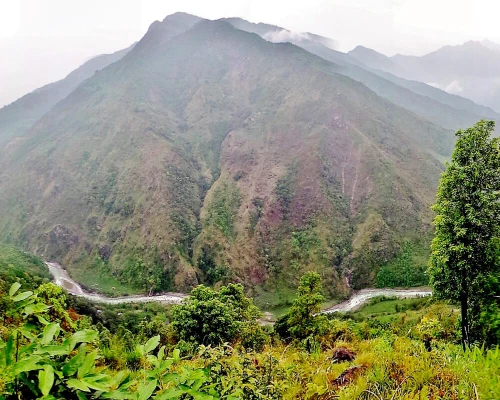
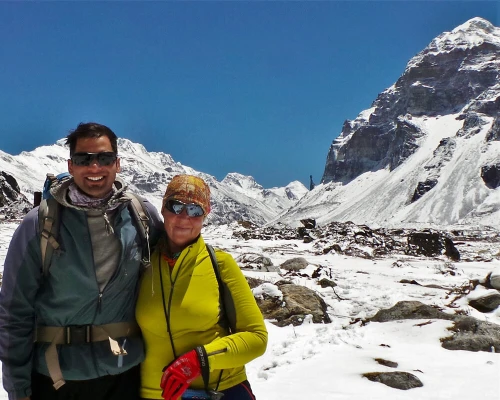
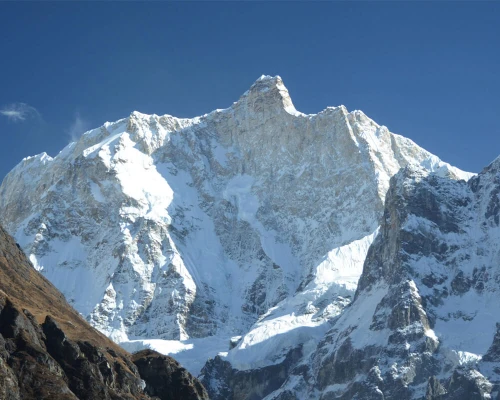
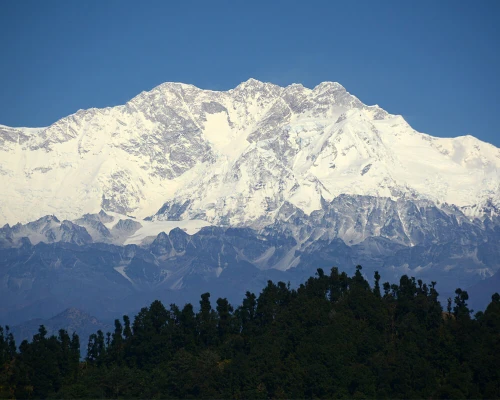
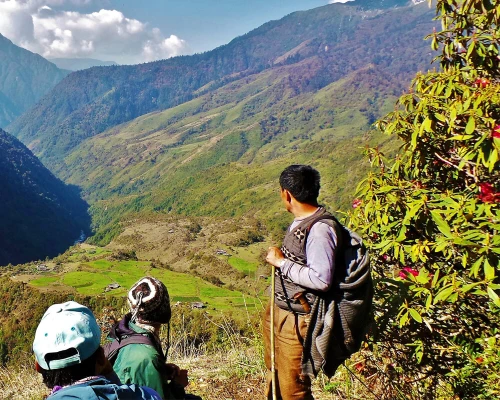

 based on 1 review
based on 1 review



